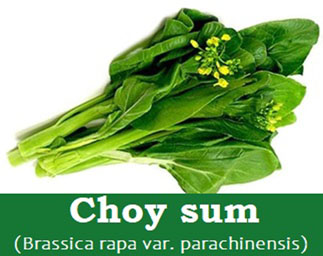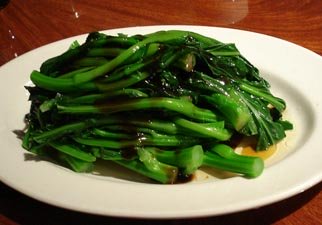Choy Sum Nutrition facts
Choy sum, also known as Chinese flowering cabbage, is a nutrient-rich edible flower stalk within the Brassica (mustard) family of leafy greens. This cool-season leafy veggie is also spelled “Cài xīn” ((菜心), which means “the heart of a cabbage".
Botanical name: Brassica rapa var. parachinensis.
Other common Names: Yu Choy Sum, Cantonese pak choy, yellow flower choi sum, and sawi bunga (Malay).
 |
Choy sum, a small annual herbaceous plant, typically grows to a height of 7 to 15 inches. It thrives in frost-free, cool climates ranging from 15°C to 25°C, which fosters robust stalks and enhances sweetness.
Ideal planting times for choy sum are in mid-to-late spring and early autumn to avoid frost. It prefers well-drained, fertile soils with adequate moisture.
Choy sum exhibits alternate leaves and small, four-petaled yellow flowers atop each shoot. The leaves are ovate and light to dark green or even purple on some varieties like purple-Cài xīn (Hon Tsai Tai). As it matures, the flowers develop into silique fruit containing small, dark, round seeds.
Harvesting typically commences 30–50 days after sowing, when the flower buds are fully formed but not yet open. Leaves, flower buds, and stems are harvested together for sale in markets.
Choy sum Health benefits
Choy sum leaves and stems are abundant in phytonutrients known for their health-promoting and disease-preventing properties.
It is a low-calorie (48 calories per 100 g of raw leaves), low-fat leafy vegetable. Nonetheless, its dark green leaves and stems carry plenty of health-benefiting antioxidants, vitamins, and minerals.
Choy sum greens are particularly high in dietary fiber, aiding in cholesterol control, promoting smooth bowel movements, and providing protection against conditions like hemorrhoids and colon cancer.
Choy sum is abundant in antioxidants such as flavonoids, indoles, sulforaphane, carotenes, lutein, and zeaxanthin. Specifically, indoles, including Di-indolyl-methane (DIM) and sulforaphane, have demonstrated benefits against prostate, breast, colon, and ovarian cancers due to their ability to inhibit cancer-cell growth and exert cytotoxic effects on cancer cells.
Fresh choy sum leaves are an excellent natural source of folates, providing 425 μg or 106% of the daily recommended intake per 100 grams, crucial for combating anemia and preventing neural tube defects in infants.
These greens are also a moderate source of other B-complex groups of vitamins such as thiamin, riboflavin, niacin, pantothenic acid, etc. Many of them play a pivotal role as cofactors in the substrate metabolism inside the human body.
Fresh choi sum is an excellent sources of vitamin-C. 3.5 Oz (100 g) fresh leaves provide 46 mg or about 71% of the recommended daily intake. Vitamin C (ascorbic acid) is a powerful water-soluble antioxidant that offers protection against free radical injury and flu-like viral infections.
Choy sum leaves are also a very good source of vitamin-A (provide 766 IU or 25.5% of RDA per 3.5 Oz (100 g). vital for maintaining healthy vision, hair, and skin. Regular consumption of natural foods rich in retinol equivalents (flavonoid compounds) has been shown to provide protection against lung and oral cavity cancers.
Fresh Choy sum is an excellent source of several essential minerals such as calcium 70 mg (7% RDA), iron 1.7 mg (21% RDA), magnesium, potassium, and zinc.
Regular inclusion of choy sum in the diet may help prevent osteoporosis, iron and folate deficiency anemia, and could potentially lower the risk of cardiovascular diseases, colon cancer, and prostate cancer.
| Principle | Nutrient Value | Percent of RDA |
|---|---|---|
| Energy | 48 Kcal | 2.4% |
| Carbohydrates | 0.8 g | <1% |
| Protein | 1.3 g | 2% |
| Total Fat | 0.3 g | 1.5% |
| Cholesterol | 0 mg | 0% |
| Dietary Fiber | 2.8 g | 7% |
| Vitamins | ||
| Folates | 425 μg | 106% |
| Niacin | 0.8 mg | 5% |
| Pyridoxine | 0.09 mg | 7% |
| Riboflavin | 0.1 mg | 7.7% |
| Thiamin | 0.01 mg | <1% |
| Vitamin A | 767 IU | 25.5% |
| Vitamin C | 46 mg | 71% |
| Electrolytes | ||
| Sodium | 13 mg | 1% |
| Potassium | 340 mg | 7% |
| Minerals | ||
| Calcium | 70 mg | 7% |
| Iron | 1.7 mg | 21% |
| Magnesium | 12 mg | 3% |
| Phosphorus | 40 mg | 5.5% |
| Selenium | 0 µg | 0% |
| Zinc | 0.5 mg | 4.5% |
| Phyto-nutrients | ||
| Carotene-ß | 1378 μg | -- |
| Crypto-xanthin-ß | 20 µg | -- |
Selection and storage
Choy sum, native to South China, stands as one of the most sought-after leafy vegetables in local markets throughout East Asia and Southeast Asia. Nowadays, it's also readily available in specialty grocers and Asian markets across Europe, Australia, and the United States.
Choy sum offers versatility in harvesting, ranging from tender young greens to flowering tops. When young, its leaves possess a gentle flavor akin to spinach, while as it matures, the taste intensifies, resembling the pungency of mustard greens.
Choy sum is a cool-season crop. Fresh produce inundates markets, reaching its peak from fall through spring. Nevertheless, the availability of fresh produce year-round is also guaranteed, thanks to greenhouse farming practices.
When selecting choy sum at the market, opt for fresh, crisp, dark green leaves with smooth stalks and vibrant flowering tops, steering clear of any signs of wilting or discoloration.
Once at home, promptly refrigerate the leaves to maintain freshness. For optimal flavor and nutritional benefits, it is advisable to use fresh choy sum greens as soon as possible.
Choy sum can be stored for up to 3-4 days in cold storage conditions, ideally at temperatures between 5-8°C and with humidity levels exceeding 90%.
Preparation and serving methods
Choy sum is a common green leafy staple in Cantonese cuisine. Its fresh leaves, flower buds, and stems are used in a variety of cuisines across East Asia and in the West, where a significant Chinese diaspora exists.
Choy sum can be substituted for gai lan, mustard greens, broccoli rabe, etc., in similar cooked dishes.
Before cooking, thoroughly wash the leaves in clean running water to remove any sand or insecticide residues. Trim away thick petioles and stems.
Here are some serving ideas:
 |
| Choy sum stir fry in garlic sauce. Courtesy: Jonathan |
Grown-up choy sum stems and leaves may be preserved as a pickled vegetable. They are also fantastic when added to soups and stews or braised with aromatics such as rice wine, soy sauce, ginger, garlic, and spring onions.
Fresh tender choy sum greens are eaten raw in salads.
It complements well in soups and stir-fries with mushrooms, chicken, shrimp, and tofu.
Steam or blanch choy sum lightly to preserve both flavor and texture, then mix in garlic sauce and sprinkle with sesame seeds as a garnish.
Stir-fry whole or chopped choy sum in garlic oil and combine with oyster sauce.
Safety profile
Reheating leftovers of choy sum, along with other leafy greens like mustard greens and spinach, can lead to the conversion of nitrates into nitrites and nitrosamines by certain bacteria thriving on nitrate-rich foods. These toxic compounds pose potential harm to health.
Phytates and dietary fiber present in choy sum may interfere with the bioavailability of iron, calcium, and magnesium.
Choy sum, being a Brassica family vegetable, contains oxalic acid, a naturally occurring substance found in some vegetables that may crystallize as oxalate stones in the urinary tract in some people. People with known oxalate urinary tract stones are advised to avoid eating vegetables belonging to the Brassica family. Adequate intake of water is, therefore, necessary to maintain normal urine output.
Choy sum may also contain goitrogens, which may interfere with thyroid hormone production and can cause thyroxine hormone deficiency in individuals with thyroid dysfunction.
(Medical Disclaimer: The information and reference guides on this website are intended solely for the general information of the reader. It is not to be used to diagnose health problems or for treatment purposes. It is not a substitute for medical care provided by a licensed and qualified health professional. Please consult your health care provider for any advice on medications.)
You may also like to read ≻≻
≺≺ Mizuna Nutrition facts.
≺≺ Tatsoi (Tai cai (塌菜)) Nutrition facts.
≺≺ Chinese-broccoli (Gai lan) Health benefits.
≺≺ Broccoli rabe Health benefits.
≺≺ Broccolini Health benefits.
≺≺ Mustard-greens Health benefits.
≺≺ Back to Vegetables from Choy sum. Visit here for an impressive list of vegetables with complete illustrations of their nutrition facts and health benefits.
≺≺ Back to Home page.
Further reading:
Refer Stanford School of Medicine Cancer information Page- Nutrition to Reduce Cancer Risk (Link opens in new window).
Food Standards Australia & New Zealand.
Production Guide for Choy Sum—An Emerging Asian Vegetable in Florida -University of Florida-IFAS Extension (Link opens in new window).
Specialty Produce (Link opens in new window).